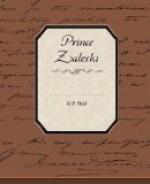I had brought with me a certain document, a massive book bound in iron and leather, the diary of one Sir Jocelin Saul. This I had abstracted from a gentleman of my acquaintance, the head of a firm of inquiry agents in London, into whose hand, only the day before, it had come. A distant neighbour of Sir Jocelin, hearing by chance of his extremity, had invoked the assistance of this firm; but the aged baronet, being in a state of the utmost feebleness, terror, and indeed hysterical incoherence, had been able to utter no word in explanation of his condition or wishes, and, in silent abandonment, had merely handed the book to the agent.
A day or two after I had reached the desolate old mansion which the prince occupied, knowing that he might sometimes be induced to take an absorbing interest in questions that had proved themselves too profound, or too intricate, for ordinary solution, I asked him if he was willing to hear the details read out from the diary, and on his assenting, I proceeded to do so.
The brief narrative had reference to a very large and very valuable oval gem enclosed in the substance of a golden chalice, which chalice, in the monastery of St. Edmundsbury, had once lain centuries long within the Loculus, or inmost coffin, wherein reposed the body of St. Edmund. By pressing a hidden pivot, the cup (which was composed of two equal parts, connected by minute hinges) sprang open, and in a hollow space at the bottom was disclosed the gem. Sir Jocelin Saul, I may say, was lineally connected with—though, of course, not descendant from—that same Jocelin of Brakelonda, a brother of the Edmundsbury convent, who wrote the now so celebrated Jocelini Chronica: and the chalice had fallen into the possession of the family, seemingly at some time prior to the suppression of the monastery about 1537. On it was inscribed in old English characters of unknown date the words:
’Shulde this Ston stalen bee,
Or shuld it chaunges dre,
The Houss of Sawl and hys Hed anoon shal
de.’
The stone itself was an intaglio, and had engraved on its surface the figure of a mythological animal, together with some nearly obliterated letters, of which the only ones remaining legible were those forming the word ‘Has.’ As a sure precaution against the loss of the gem, another cup had been made and engraved in an exactly similar manner, inside of which, to complete the delusion, another stone of the same size and cut, but of comparatively valueless material, had been placed.




